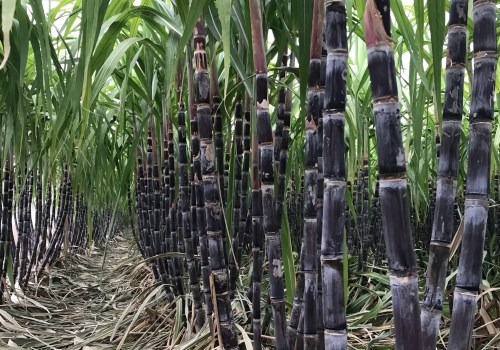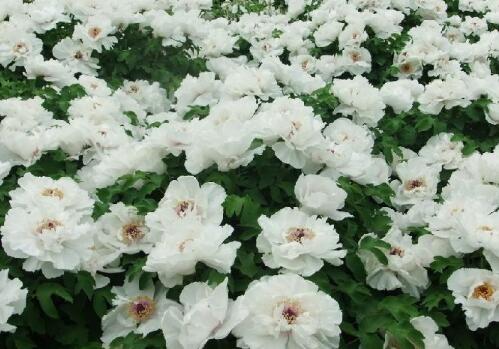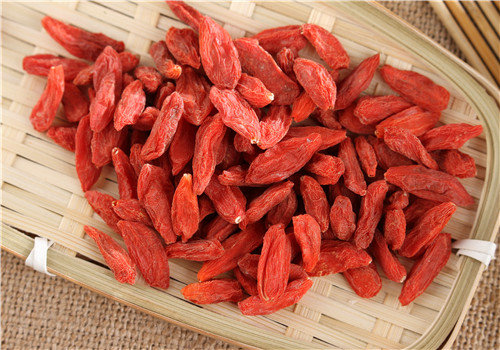Introduction of sugarcane planting technology of Gramineae plants! What varieties should be planted in 2019?
Sugarcane is a gramineous sugarcane plant, the stem is cylindrical, there are nodes on the stem, solid internodes, colors are purple, red or yellowish green, etc., can be eaten fresh, eat sweet, many people like to eat. So, how to grow sugarcane? Here is to introduce the technology of sugarcane planting.

A brief introduction to sugarcane!
Is sugarcane a fruit?
Fruit refers to the fruit of a plant, while sugarcane is the stem of a plant, and from a botanical point of view, sugarcane is not a fruit; but fruit also refers to food that is succulent and mainly tastes sweet and sour, although sugarcane is not a fruit, but it also belongs to succulent and sweet food, so it's a special fruit.
2. Is it hot to eat sugarcane?
Eating sugarcane will not catch fire, because it is a cool fruit, it has the effect of clearing away heat and detoxification after eating, in addition, it also has the effects of invigorating body and relieving thirst, relieving vomiting, nourishing yin and moistening dryness, etc., which can be eaten by ordinary people, but those with cold pain in spleen and stomach and cold in stomach and abdomen cannot eat.
Second, introduction of sugarcane planting technology!
1. Land preparation
The land for planting sugarcane should have deep, loose and fertile soil conditions. after selecting the land, plough about 30 centimeters deeply, and then spread basic fertilizer; then open a sugarcane ditch with a depth of about 20 centimeters, a width of 20-25 centimeters, a distance of 100 centimeters between the center and a flat bottom.
2. Seed selection
Choose the newly planted sugarcane which grows well in the field and has no harm to diseases and insect pests, and if the seedlings are insufficient, you can also stay in the root sugarcane as a seed; in order to increase the germination rate, speed up the germination rate and reduce diseases and insect pests, the seedlings need to go through seed drying, seed soaking and disinfection and germination treatment.
3. Seeding
Generally, the temperature within 10 cm of topsoil is stable above 10 ℃, and the density should be reasonable. If planting is too sparse, the number of effective stems is less, the yield is not high, and if the plant is too dense, the weak stem is thin, the dead stem increases, the sucrose content is low, and the sugar yield per mu is not high; if the temperature is high, the water and fertilizer conditions are good, the amount of seed can be less, and vice versa; the varieties with thin and erect stems can be denser, and vice versa.
4. Supplementary seedling, intermediate seedling and fixed seedling
When the sprouting is basically over and the sugarcane seedlings grow 3-5 true leaves, check to see if there are any missing seedlings, and if you see that the missing seedlings should be replenished in time; in addition to checking the missing seedlings, you should also carry out inter-seedling, remove too many tillers and reduce nutrient consumption; determine the number of effective stems per mu and retain the appropriate number of seedlings per mu.
5. Weeding, ploughing and soil cultivation
Before the sugarcane is closed, weeds are easy to grow and nutrients are consumed to cover the sugarcane seedlings, so weeding should be carried out in time, generally combined with ploughing and soil cultivation; there are 6-7 true leaves in the seedlings, and the soil height is about 3 cm when tillering occurs. At the peak tillering stage, the height of soil cultivation is about 6 cm when the sugarcane plant is closed, and 20-30 cm at the initial stage of elongation.
6. Fertilization
Sugarcane needs a large amount of fertilizer, so it is necessary to apply heavy base fertilizer and topdressing by stages. The application principle of topdressing can be summarized as "three attacks and one supplement, light at both ends and heavy in the middle". "three attacks" is to attack seedling fertilizer, tiller fertilizer and stem fertilizer. "one supplement" means supplementary application of strong tail fertilizer in the later stage, "light at both ends" refers to less fertilizer application in seedling stage and late elongation stage, and "middle heavy" refers to more fertilizer application in the early stage of elongation.
7. Watering
Sugarcane needs a lot of water in its lifetime but is not resistant to waterlogging. The general trend of water demand is "less at both ends, more in the middle", less at germination, tillering and maturity, and large at elongation. Sugarcane fields should be kept in the state of "moist-wet-moist" respectively. Do not accumulate water, otherwise it will cause rotting roots.
8. Stripping leaves
With the extension of the sugarcane, the basal leaves will gradually wither and yellow. if you want to get rid of the withered and yellow leaves, especially in the hot and humid sugarcane area, you must peel off the leaves; if it is an arid area, you should not hit the leaves to protect water and drought; if you stay in the field, you should not hit the leaves to ensure that the buds of sugarcane will not be damaged.
9. Diseases and insects
Sugarcane diseases include pineapple disease, red rot, smut, white leaf disease, scab, leaf blight, and so on. Once the disease is acquired, there is no cure, so it can only be uprooted and burned. Therefore, it is necessary to strengthen prevention or breed disease-resistant varieties. Insect pests are borers, cotton aphids, powder shell insects, sugarcane turtles, thrips and so on, which can be controlled by pesticides.
What sugarcane varieties should be planted in 2019?
According to the use, sugarcane can be divided into fruit cane and sugar cane:
1. Sugarcane: it is specially used for fresh food, and there are many varieties, such as Tanzhou sugarcane and Haifeng sugarcane in Guangdong, Baimei sugarcane and Tongan sugarcane in Fujian, Qingpi sugarcane in Hangzhou and Taoshan sugarcane in Ruian, crispy sugarcane in Sichuan, crispy sugarcane and white sugarcane in Dahongpao, and red sugarcane in Guangxi.
2. Sugar cane: it is used to make sugar, and there are many varieties, such as Guitang 1, Guitang 2, Guitang 3, Guitang 7, Guitang 10, Guitang 11, TSC 20, TSC 22, TSC 24, TSC 26 and so on.
The above is the introduction of sugarcane planting technology and 2019 varieties. I hope it will be useful to you.
When will sugarcane be planted? Planting time and method of sugarcane
Sugarcane planting time
Under normal conditions, sugarcane should be planted between late February and early April.
Little knowledge of sugarcane planting
Land selection and preparation: sandy loam fields with deep soil layer, fertile soil, loose texture, good drainage and irrigation, convenient transportation and sufficient sunshine are required to rotate every 2-3 years. After soil preparation and soil moisture continuous cropping, the residue should be burned in time after harvest, and the field should be flooded for more than a week. The residue and pests in the soil should be eliminated and ploughed again after the water is dry. The depth should be more than 30 cm.
Planting management: the planting time of sugarcane is from September of that year to February of the next year, and there is no sugarcane seed too early, which affects the yield and quality too late. Before planting, combined with the bottom of the pine ditch, the bottom fertilizer should be applied to the bottom of the ditch, and then planted after applying the bottom fertilizer, and the new high lipid film should be sprayed on the branches before planting to greatly improve the germination rate. The planting density is generally controlled at about 20 buds per meter to ensure that the effective stem per mu is not less than 4500.
Mid-tillage management: after emergence, combined with the first weeding, 15 kg urea per mu. Fertilization during the growing period combined with each soil cultivation at the same time, timely application of foliar fertilizer and balance fertilizer. Sugarcane needs a large amount of water, so we should pay attention to timely irrigation, but we should avoid flood irrigation, advocate light water irrigation, keep the soil dry and wet, give priority to moisture, and timely spray new high-fat film to protect soil moisture. Peeling leaves of sugarcane plants began to peel leaves after elongation, each time peeling leaves 3 Mur4 pieces, too much leaf peeling affects plant growth, leaf peeling does not affect powder in time, spraying Zhuangtuanling can make plant stems sturdy and greatly increase yield.
Where is the producing area of sugarcane? details of sugarcane planting techniques in South China
Content Abstract: sugarcane, recorded in "Gramineae", is a common plant, edible and mainly used to make sugar. according to the skin color of sugarcane, it can be divided into purple and green. it is understood that sugarcane can be produced in hundreds of countries. it shows the degree of market demand, what this article mainly brings to you is the producing area of sugarcane and its planting technology.
[where is the producing area of sugarcane]
Sugarcane is a light-loving plant, so there are strict requirements for planting, climate and precipitation in the producing area, requiring an annual accumulated temperature of about 5500-8500 degrees Celsius, while the average annual precipitation is about 800-****mm, and the annual sunshine hours are more than 1195 hours.
Distribution of sugarcane abroad: sugarcane is mainly for sugar production and fruit consumption, while abroad is mainly distributed in tropical and subtropical regions. Brazil is the largest sugarcane producing area abroad, and the second is India. Secondly, Cuba, Mexico, the United States, Thailand, Australia and other regions are also the main producing areas of sugarcane.
Domestic distribution: China is known as the third sugarcane growing country in the world, so sugarcane is a common plant in most parts of the country, while the main producing areas of sugarcane in China are mainly concentrated in subtropical areas, such as Guangdong, Fujian, Guizhou, Zhejiang and so on. Secondly, it is also planted in Sichuan, Yunnan, Hunan and Hainan in the south of China, while Henan, Shandong and other provinces It belongs to the area where sugarcane is scattered.
[detailed explanation of Sugarcane planting techniques in South China]
Sugarcane is a light-loving plant, while the southern part of China is a warm area, the climate adaptability is not strong, but considering the mild temperature in the south, it is suggested to choose open-air planting.
① site preparation
The selection of sugarcane land should be deep ploughing, it is recommended to choose large-scale mechanical ploughing field, because sugarcane itself belongs to deep-rooted plants, the field must be treated by deep ploughing, soil selection is not required, weeds and stones can be cleaned up in the field.
② opened sugarcane ditch
The first kind: the opening and finishing of conventional sugarcane ditch, only need to keep the spacing of 20 cm, the bottom of the ditch is parallel, the width is about 25 cm.
The second kind: the second kind of sugarcane ditch, which can be called ditch canal. according to the soil preparation method of sweet potato, the depth of the ditch is about 40 cm and the width at the bottom is 25 cm.
③ fertilization
Fertilizer requirement: sugarcane needs a large amount of fertilizer. According to experts, for every ton of finished sugar cane, about 100 kilograms of fertilizer is needed for planting.
Principle of fertilization: sugarcane fertilization is not recommended topdressing, so it is necessary to apply sufficient base fertilizer after soil preparation, which can avoid the uneven growth of sugarcane.
Fertilization options: sugarcane needs nitrogen fertilizer, potassium fertilizer, organic fertilizer and so on.
④ seed
The seeds of sugarcane can choose to be dominated by sugarcane plants. When harvesting sugarcane, the unflowered sugarcane plants will be harvested with a length of about 30 centimeters. It is generally recommended to start from the lower position of the sugarcane bud, it is recommended to choose a sharp knife, do not damage the sugarcane species.
Peel off its slightly older leaf sheath and expose it in the hot sun for about two days; then soak it in clean water, or add an appropriate amount of lime powder to the water for two days, then take it out and peel off the leaves
When planting, the distance between each plant is about 10 cm, while in the areas where the temperature is relatively high and the water and fertilizer conditions are good, it is suggested that the spacing should be increased appropriately, on the contrary, for the slender sugarcane varieties that are not easy to grow, the planting spacing is suggested to be a little denser.
⑤ field management
Watering: sugarcane only needs to be watered in the hot summer season, once a week, while in the normal rainy season, there is no need to water, on the contrary, when the field is flooded, it needs to be drained in time.
Leaf stripping: after sugarcane enters the growth stage, with the elongation of nodes, it is necessary to peel leaves artificially, and the principle of leaf peeling is mainly withered and yellow leaves.
Cultivate the soil: the growth of sugarcane is very fast, in order to avoid the dumping of sugarcane, it is necessary to cultivate the soil about three times during the whole growth period.
Interseedling: after sugarcane is planted for about a month, the work of interseedling and replenishment can be carried out to loosen the over-dense sugarcane seedlings.
Weeding: sugarcane has a large demand for fertilizer, so after the emergence of weeds, it should be cleaned up in time, generally recommended manual weeding, followed by the choice of "simajin" and "atrazine" herbicides to avoid contact with sugarcane roots.
- Prev

What is the income of planting one mu of oil peony? What are the high-yield cultivation techniques?
Since the Tang Dynasty, peony has been regarded as the national flower, whether it is medicinal, ornamental or edible, and the oil peony is widely planted as an oil crop. How much is the income from planting an acre of oil peony? What are the high-yield cultivation techniques? The basic situation of oil peony
- Next

What is the prospect of planting Chinese wolfberry in 2019? How is the market?
As a common health product in our daily life, Chinese wolfberry is basically a must in every family. Can not be able to tonify the blood can also act as food excipients on the table, the effect is very many. Then many friends will also have doubts, want to come to this industry to try but have no experience. For example, what is the prospect of planting Chinese wolfberry in 2019?
Related
- Fuxing push coffee new agricultural production and marketing class: lack of small-scale processing plants
- Jujube rice field leisure farm deep ploughing Yilan for five years to create a space for organic food and play
- Nongyu Farm-A trial of organic papaya for brave women with advanced technology
- Four points for attention in the prevention and control of diseases and insect pests of edible fungi
- How to add nutrient solution to Edible Fungi
- Is there any good way to control edible fungus mites?
- Open Inoculation Technology of Edible Fungi
- Is there any clever way to use fertilizer for edible fungus in winter?
- What agents are used to kill the pathogens of edible fungi in the mushroom shed?
- Rapid drying of Edible Fungi

